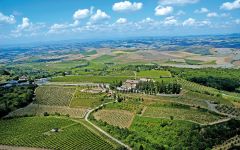Conti Costanti Brunello di Montalcino 2015
- Decanter
-
Wine
Enthusiast -
Robert
Parker -
Wine
Spectator



Product Details
Your Rating
Somm Note
Winemaker Notes
Deep ruby red with brilliant garnet reflections, the bouquet is rich, ample and intense with notes of brushwood, berries, plums, violets, spices and vanilla confirmed on the palate; wonderful elegance and balance, lush concentration, voluptuous body and silky, smooth tannins. Shows power and finesse all at once.
A wonderful accompaniment to red meat, stews, complex dishes and aged cheese.
Professional Ratings
-
Decanter
After sitting out the 2014 vintage, Andrea Costanti calls 2015 a beautiful year and one of the best in the history of Brunello. He deemed it exceptional enough to craft a Riserva (to be released in 2021) yet his classic Brunello hasn't suffered for it. In fact, it's one of the greatest successes of the vintage. Gorgeous, seductive aromas are already expressive but still youthful. Cherry and plum are enveloped by exotic spice and a faint smokiness. The palate is plush and velvety with layers of powdery tannins that build, and tangy acid that cleanses the palate. Hedonistic but brilliantly balanced, it is hard to resist now but the best is definitely yet to come.
-
Wine Enthusiast
Fragrant and all about finesse, this gorgeous wine opens with enticing aromas of blue flower, forest floor, wild berry and a whiff of eucalyptus. It's linear and elegant, delivering succulent red cherry, pomegranate, star anise and tobacco alongside polished tannins. Fresh acidity keeps it impeccably balanced. Drink 2022–2030.
-
Robert Parker's Wine Advocate
The Conti Costanti 2015 Brunello di Montalcino is vinous and ripe with lots of energy that comes from plummy black fruit and dried blackberry. The wine is front-loaded with those varietal tones, but the mouthfeel reveals a more delicate and softer approach than you might expect given the potency of that first nose. The wine achieves harmony, and offers a nice, long finish. The label states that fruit comes from the Colle al Matrichese, but I am not sure if that is an official estate vineyard designation. Either way, this is a serious cellar-worthy Brunello to sip and consider with a platter of fine cheeses.
-
Wine Spectator
A fruity style, featuring black cherry and black currant flavors, supported by notes of iron, leather and tobacco. Taut and vibrant, with a lingering finish. Best from 2023 through 2042.
Other Vintages
2018- Decanter
-
Wine
Spectator -
Robert
Parker
-
Wine
Enthusiast - Decanter
-
Robert
Parker -
Wine
Spectator
-
Wine
Enthusiast - Decanter
-
Wine
Spectator -
Robert
Parker
-
Wine
Enthusiast - Decanter
-
Wine
Spectator -
Wine &
Spirits
-
Wine
Enthusiast -
Wine
Spectator -
Robert
Parker
-
Wine
Enthusiast -
Wine &
Spirits -
James
Suckling - Decanter
-
Wine
Spectator -
Robert
Parker
-
Wine
Enthusiast -
Wine
Spectator
-
Robert
Parker -
James
Suckling -
Wine
Spectator -
Wine
Enthusiast
-
Robert
Parker -
Wine
Enthusiast
-
Robert
Parker -
Wine
Spectator
-
Robert
Parker -
Wine &
Spirits -
Wine
Spectator -
James
Suckling
-
Robert
Parker
-
Wine
Spectator -
Robert
Parker
-
Wine &
Spirits





The small town of Montalcino, huddled around its fortressed castle on the Tuscan hillside, is miniature perfection. Montalcino residents are a tightly knit community, with a strong sense of identity and deep love for their territory. Within this community, Andrea Costanti is a well known and highly liked figure. The Costanti family has been part of Montalcino history since 1555, yet Andrea is anything but 'old hat': young, brilliant and amiable, he very much moves with the times. You will find him perfectly at ease in Tuscany as in New York, in Paris or in Tokyo. In 1983, Andrea (at the time, fresh out of Siena University's geology department) took over from his uncle, Count Emilio – the man who first put Costanti on the wine map. A difficult task: yet this inexperienced youth not only coped with his huge new responsibilities, but actually upgraded and enhanced the family's reputation for making great Brunello. He achieved this by relying on his own fine instinct for wine and in-depth knowledge of the terrain's geological components. In time, these natural skills were perfected, so that he eventually styled the range together with Vittorio Fiore. Roughly 25 acres are under vine and vine age ranges from 6 to 25 years old. Soil type is classic Tuscan "galestro" (shale marls from the Cretaceous Era, formed by a mixture of sand and calcareous rock with very little clay).

Among Italy's elite red grape varieties, Sangiovese has the perfect intersection of bright red fruit and savory earthiness and is responsible for the best red wines of Tuscany. While it is best known as the chief component of Chianti, it is also the main grape in Vino Nobile di Montepulciano and reaches the height of its power and intensity in the complex, long-lived Brunello di Montalcino. Somm Secret—Sangiovese doubles under the alias, Nielluccio, on the French island of Corsica where it produces distinctly floral and refreshing reds and rosés.

Famous for its bold, layered and long-lived red, Brunello di Montalcino, the town of Montalcino is about 70 miles south of Florence, and has a warmer and drier climate than that of its neighbor, Chianti. The Sangiovese grape is king here, as it is in Chianti, but Montalcino has its own clone called Brunello.
The Brunello vineyards of Montalcino blanket the rolling hills surrounding the village and fan out at various elevations, creating the potential for Brunello wines expressing different styles. From the valleys, where deeper deposits of clay are found, come wines typically bolder, more concentrated and rich in opulent black fruit. The hillside vineyards produce wines more concentrated in red fruits and floral aromas; these sites reach up to over 1,600 feet and have shallow soils of rocks and shale.
Brunello di Montalcino by law must be aged a minimum of four years, including two years in barrel before realease and once released, typically needs more time in bottle for its drinking potential to be fully reached. The good news is that Montalcino makes a “baby brother” version. The wines called Rosso di Montalcino are often made from younger vines, aged for about a year before release, offer extraordinary values and are ready to drink young.
